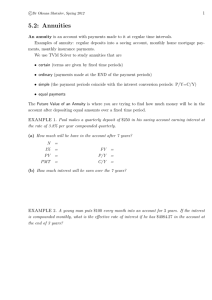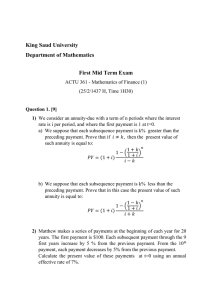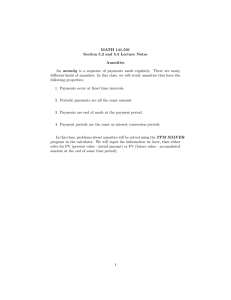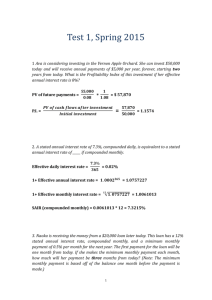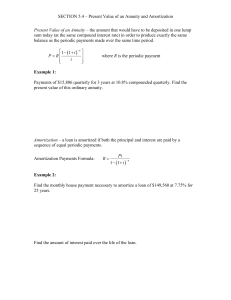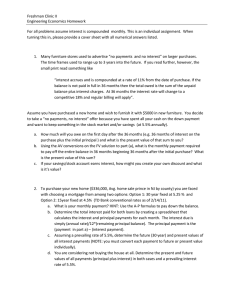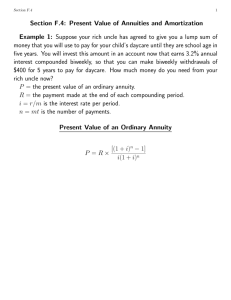§5.2-3 Annuities, Amortization of Loans
advertisement
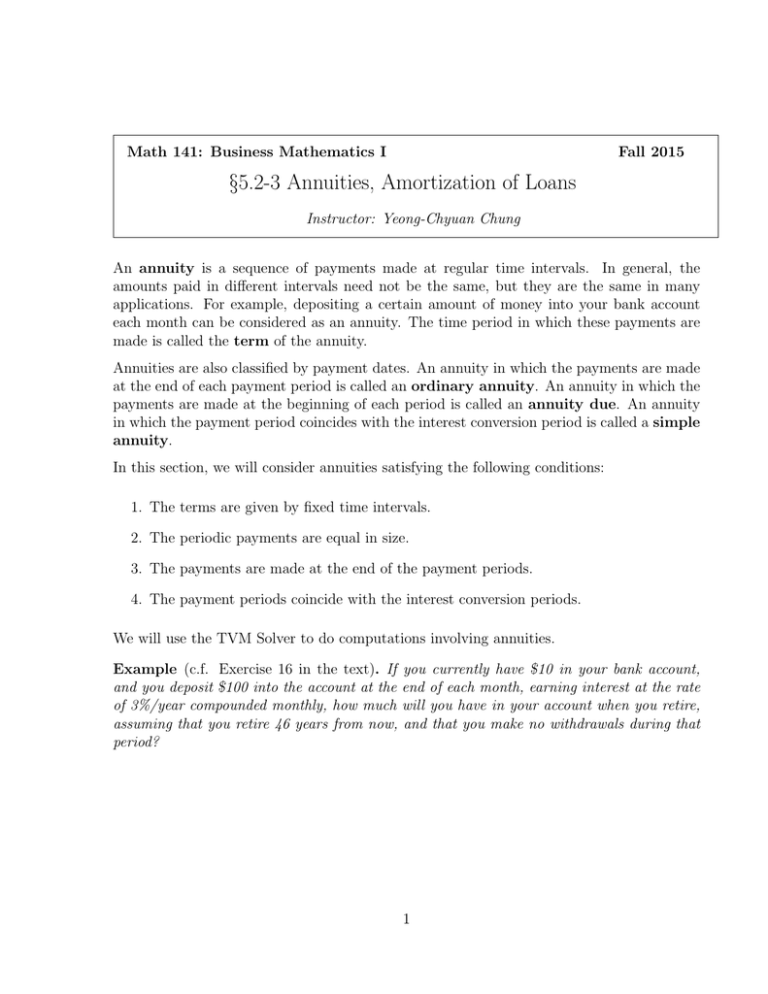
Math 141: Business Mathematics I Fall 2015 §5.2-3 Annuities, Amortization of Loans Instructor: Yeong-Chyuan Chung An annuity is a sequence of payments made at regular time intervals. In general, the amounts paid in different intervals need not be the same, but they are the same in many applications. For example, depositing a certain amount of money into your bank account each month can be considered as an annuity. The time period in which these payments are made is called the term of the annuity. Annuities are also classified by payment dates. An annuity in which the payments are made at the end of each payment period is called an ordinary annuity. An annuity in which the payments are made at the beginning of each period is called an annuity due. An annuity in which the payment period coincides with the interest conversion period is called a simple annuity. In this section, we will consider annuities satisfying the following conditions: 1. The terms are given by fixed time intervals. 2. The periodic payments are equal in size. 3. The payments are made at the end of the payment periods. 4. The payment periods coincide with the interest conversion periods. We will use the TVM Solver to do computations involving annuities. Example (c.f. Exercise 16 in the text). If you currently have $10 in your bank account, and you deposit $100 into the account at the end of each month, earning interest at the rate of 3%/year compounded monthly, how much will you have in your account when you retire, assuming that you retire 46 years from now, and that you make no withdrawals during that period? 1 2 §5.2-3 Annuities, Amortization of Loans Example. In the previous example, how much would you need to deposit into your account each month if you want $1,000,000 when you retire (with the same assumptions as before)? What is the total amount of money you would have actually deposited? Example. If instead you wait 10 years to start depositing money into your account, how much would you need to deposit each month if you want $1,000,000 when you retire? What is the total amount of money you would have actually deposited? Example (Exercise 20 in the text). As a fringe benefit for the past 12 years, Colin’s employer has contributed $100 at the end of each month into an employee retirement account for Colin that pays interest at the rate of 5%/year compounded monthly. Colin has also contributed $2000 at the end of each of the last 8 years into an IRA that pays interest at the rate of 4.5%/year compounded yearly. How much does Colin have in his retirement fund at this time? In situations involving loans, the borrower is typically required to repay the lender in periodic installments, usually of the same size and over a fixed term, so that the loan is amortized at the end of the term. We may think of the monthly loan repayments as the payments in an annuity. An amortization schedule is a table that contains information about the interest charged, the repayment made, the payment made towards the principal, and the outstanding balance/principal. §5.2-3 Annuities, Amortization of Loans 3 We will still use the TVM Solver to deal with problems involving loans. In such situations, PV represents the beginning balance of the loan, and FV represents the ending balance of the loan (usually 0). Example (Exercise 20 in the text). What monthly payment is required to amortize a loan of $30,000 over 10 years if interest at the rate of 6%/year is charged on the unpaid balance and interest calculations are made at the end of each month? Example (c.f. Exercise 32 in the text). Joe secured a loan of $12,000 3 years ago from a bank for use toward his college expenses. The bank charged interest at the rate of 4%/year compounded monthly on his loan. Now that he has graduated from college, Joe wishes to repay the loan by amortizing it through monthly payments over 10 years at the same interest rate. (a) Find the size of the monthly payments he will be required to make. (b) How much total interest will he be paying? (c) If he decides to pay $100 extra each month, then how long will it take him to amortize the loan? (d) How much total interest will he be paying if he pays $100 extra each month? 4 §5.2-3 Annuities, Amortization of Loans Example (Exercise 24 in the text). A group of private investors purchased a condominium complex for $2 million. They made an initial down payment of 10% and obtained financing for the balance. If the loan is to be amortized over 15 years at an interest rate of 6.6%/year compounded quarterly, find the required quarterly payment. Example. Refer to the previous example. Create an amortization schedule showing the first two payments and the 51st payment. Example (Exercise 40 in the text). Paula is considering the purchase of a new car. She has narrowed her search to two cars that are equally appealing to her. Car A costs $28,000, and Car B costs $28,200. The manufacturer of Car A is offering 0% financing for 48 months with zero down, while the manufacturer of Car B is offering a rebate of $2000 at the time of purchase plus financing at the rate of 3%/year compounded monthly over 48 months with zero down. If Paula has decided to buy the car with the lower net cost to her, which car should she purchase?
